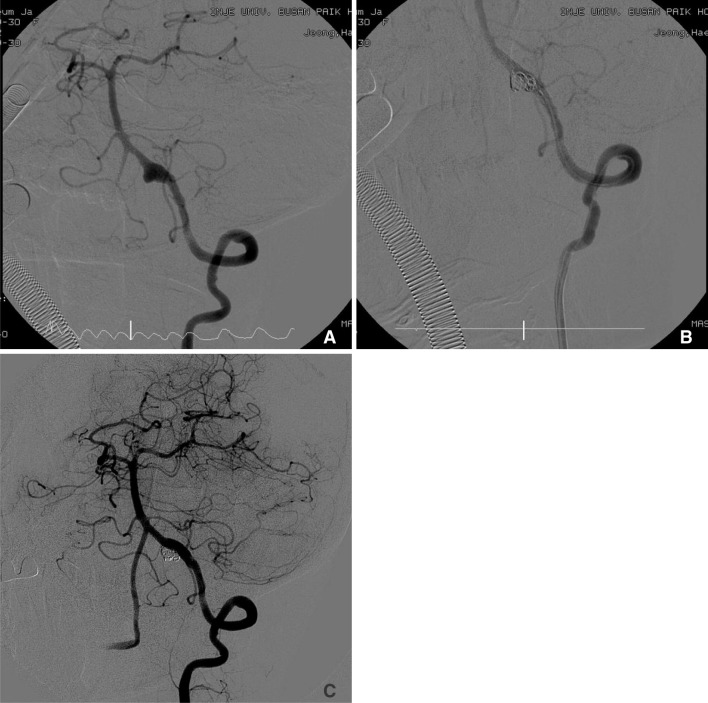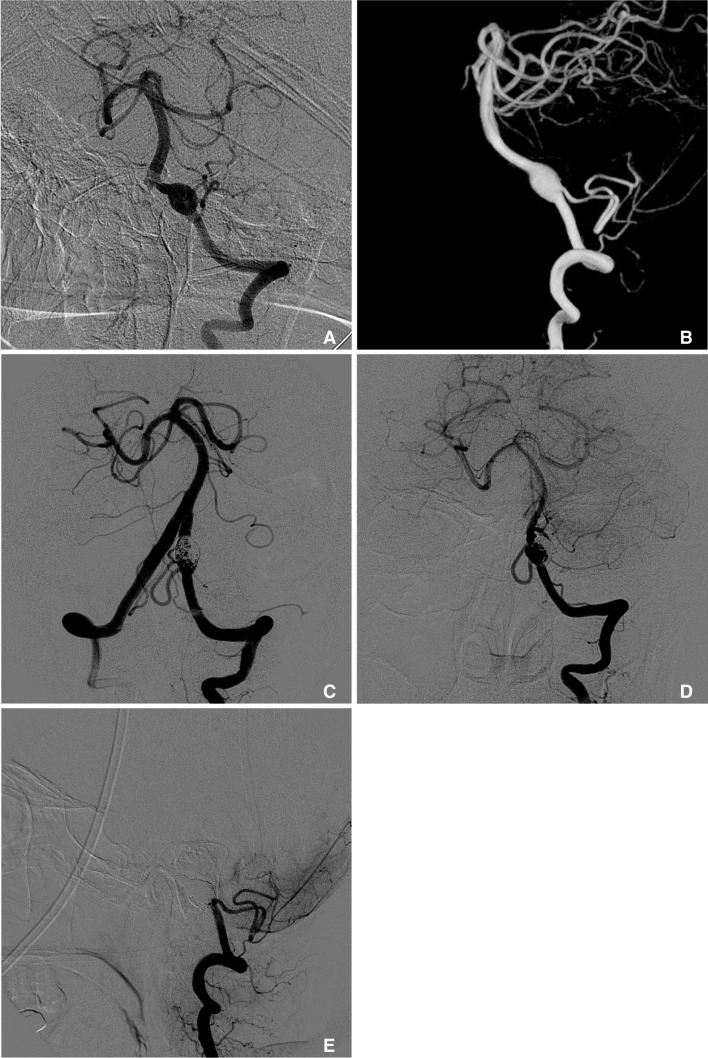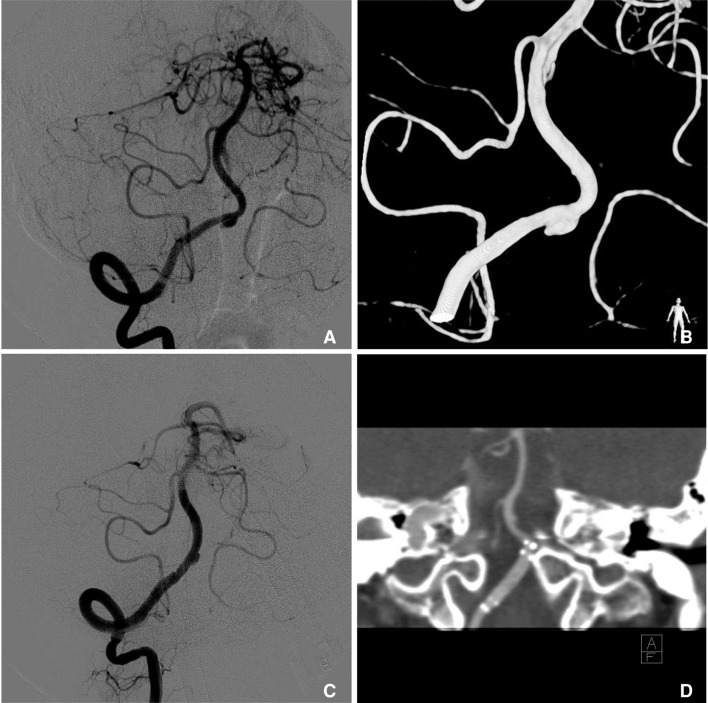Neurointervention.
2015 Feb;10(1):14-21. 10.5469/neuroint.2015.10.1.14.
Endovascular Treatment of Intracranial Vertebral Artery Dissecting Aneurysms: Follow up Angiographic and Clinical Results of Endovascular Treatment in Serial Cases
- Affiliations
-
- 1Department of Diagnostic Radiology, Busan Paik Hospital, Inje University, Busan, Korea. hwjeong2000@lycos.co.kr
- KMID: 1910755
- DOI: http://doi.org/10.5469/neuroint.2015.10.1.14
Abstract
- PURPOSE
To report angiographic and clinical results of endovascular treatment in 45 intracranial vertebral artery dissecting aneurysms (VADAs).
MATERIALS AND METHODS
From July 2002 to September 2013, a total of 42 patients with 45 VADAs received endovascular treatment. Endovascular treatment consisted of internal trapping with detachable coils, stent-assisted coiling, and stenting only. Immediate and follow-up angiographic findings and clinical outcome were retrospectively reviewed.
RESULTS
There were 17 ruptured VADAs and 28 unruptured VADAs. Overall, 26 VADAs were treated with internal trapping, 14 with stent-assisted coil embolization, and 5 with stenting only. Immediate angiographic results revealed complete occlusion in 31 cases and incomplete occlusion in 14 cases. Follow-up imaging studies were available in 31 cases. On follow-up imaging, antegrade recanalization occurred in 2 of 16 cases treated with internal trapping. Aneurysmal recurrence occurred in one case treated with stent-assisted coiling. Procedural complications occurred in 8 patients. In cases of unruptured VADA, favorable outcome (mRS 0 and 1) was achieved in 26 cases and poor outcome (mRS 2-5) in 2 cases. There was no mortality in patients with unruptured VADAs.
CONCLUSION
Endovascular treatment of intracranial VADA appears to be safe and effective. Follow-up angiographic study is needed because parent artery recanalization or aneurysmal recurrence can occur.
MeSH Terms
Figure
Reference
-
1. Jin SC, Kwon DH, Choi CG, Ahn JS, Kwun BD. Endo-vascular strategies for vertebrobasilar dissecting aneurysms. AJNR Am J Neuroradiol. 2009; 30:1518–1523. PMID: 19474118.
Article2. Prabin S, Masaaki S, Yoshihiro K, Takahito O, Kazuhiko S, Kaoru K. Endovascular coil occlusion of ruptured vertebral artery dissecting aneurysm: a case report. Neurol Asia. 2009; 14:149–152.3. Kai Y, Nishi T, Watanabe M, Morioka M, Hirano T, Yano S, et al. Strategy for treating unruptured vertebral artery dissecting aneurysms. Neurosurgery. 2011; 69:1085–1091. PMID: 21629133.
Article4. Lv X, Jiang C, Li Y, Wu Z. Clinical outcomes of ruptured and unruptured vertebral artery-posterior inferior cerebellar artery complex dissecting aneurysms after endovascular embolization. AJNR Am J Neuroradiol. 2010; 31:1232–1235. PMID: 20395384.
Article5. Fukunaga A, Tabuse M, Naritaka H, Nakamura T, Akiyama T. Spontaneous resolution of nontraumatic bilateral intracranial vertebral artery dissections. Neurol Med Chir (Tokyo). 2002; 42:491–495. PMID: 12472213.6. Naito I, Iwai T, Sasaki T. Management of intracranial vertebral artery dissections initially presenting without subarachnoid hemorrhage. Neurosurgery. 2002; 51:930–938. PMID: 12234399.
Article7. Kitanaka C, Tanaka J, Kuwahara M, Teraoka A, Sasaki T, Takakura K, et al. Nonsurgical treatment of unruptured intracranial vertebral artery dissection with serial follow-up angiography. J Neurosurg. 1994; 80:667–674. PMID: 8151345.
Article8. Sasayama T, Korosue K. Spontaneous resolution of the unruptured dissecting aneurysms of bilateral vertebral arteries with conservative treatment: analysis of the transient enlargement of aneurysmal dilatation. No Shinkei Geka. 2000; 28:47–51. PMID: 10642993.9. Coley SC, Clifton A. Dissecting vertebral artery aneurysm: diagnosis and coil embolization. Br J Radiol. 1999; 72:408–411. PMID: 10474507.
Article10. Ihn YK, Sung JH, Byun JH. Antegrade recanalization of parent artery after internal trapping of ruptured vertebral artery dissecting aneurysm. J Korean Neurosurg Soc. 2012; 51:301–304. PMID: 22792429.
Article11. Kurata A, Ohmomo T, Miyasaka Y, Fujii K, Kan S, Kitahara T. Coil embolization for the treatment of ruptured dissecting vertebral aneurysms. AJNR Am J Neuroradiol. 2001; 22:11–18. PMID: 11158881.12. Iihara K, Sakai N, Murao K, Sakai H, Higashi T, Kogure S, et al. Dissecting aneurysms of the vertebral artery: a management strategy. J Neurosurg. 2002; 9:259–267. PMID: 12186451.
Article13. Yuki I, Murayama Y, Vinuela F. Endovascular management of dissecting vertebrobasilar artery aneurysms in patients presenting with acute subarachnoid hemorrhage. J Neurosurg. 2005; 103:649–655. PMID: 16266047.
Article14. Rabinov JD, Hellinger FR, Morris PP, Ogilvy CS, Putman CM. Endovascular management of vertebrobasilar dissecting aneurysms. AJNR Am J Neuroradiol. 2003; 24:1421–1428. PMID: 12917140.15. Hamada J, Kai Y, Morioka M, Yano S, Todaka T, Ushio Y. Multimodal treatment of ruptured dissecting aneurysms of the vertebral artery during the acute stage. J Neurosurg. 2003; 99:960–966. PMID: 14705721.
Article16. Anxionnat R, de Melo Neto JF, Bracard S, Lacour JC, Pinelli C, Civit T, et al. Treatment of hemorrhagic intracranial dissections. Neurosurgery. 2003; 53:289–301. PMID: 12925243.
Article17. Yamaura I, Tani E, Yokota M, Nakano A, Fukami M, Kaba K, et al. Endovascular treatment of ruptured dissecting aneurysms aimed at occlusion of the dissected site by using Guglielmi detachable coils. J Neurosurg. 1999; 90:853–856. PMID: 10223450.
Article18. Halbach VV, Higashida RT, Dowd CF, Fraser KW, Smith TP, Teitelbaum GP, et al. Endovascular treatment of vertebral artery dissections and pseudoaneurysms. J Neurosurg. 1993; 79:183–191. PMID: 8331398.
Article19. Baik SK, Kim YS, Lee HJ, Park J, Kang DS. Antegrade recanalization of parent artery in internal trapping of vertebral artery dissecting aneurysm: a case report. Surg Neurol. 2007; 68:108–111. PMID: 17586243.
Article20. Sawada M, Kaku Y, Yoshimura S, Kawaguchi M, Matsuhisa T, Hirata T, et al. Antegrade recanalization of a completely embolized vertebral artery after endovascular treatment of a ruptured intracranial dissecting aneurysm. Report of two cases. J Neurosurg. 2005; 102:161–166. PMID: 15658109.21. Canton G, Levy DI, Lasheras JC, Nelson PK. Flow changes caused by the sequential placement of stents across the neck of sidewall cerebral aneurysms. J Neurosurg. 2005; 103:891–902. PMID: 16304994.
- Full Text Links
- Actions
-
Cited
- CITED
-
- Close
- Share
- Similar articles
-
- Endovascular Surgery of Vertebral Artery Dissecting Aneurysm
- Endovascular Treatments for Ruptured Intracranial Vertebral Artery Dissecting Aneurysms: Experience in 16 Patients
- Endovascular Treatment of Ruptured Dissecting Aneurysms on the P2-3 Segment of the Posterior Cerebral Artery: A Report of Two Cases
- Comparison of Endovascular Treatments of Ruptured Dissecting Aneurysms of the Intracranial Internal Carotid Artery and Vertebral Artery with a Review of the Literature
- A Case of Endovascular Treatment for Followed by Side to Side Bypass for Vertebral Artery Dissecting Aneurysms Involved Posterior Inferior Cerebellar Artery





